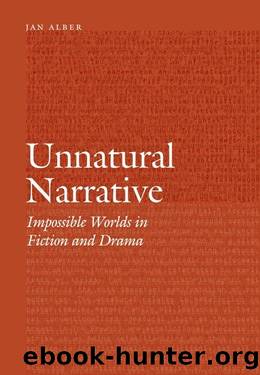Unnatural Narrative: Impossible Worlds in Fiction and Drama (Frontiers of Narrative) by Jan Alber

Author:Jan Alber [Alber, Jan]
Language: eng
Format: azw3
Tags: LIT000000 Literary Criticism / General
ISBN: 9780803288058
Publisher: UNP - Nebraska
Published: 2016-02-29T16:00:00+00:00
4.3. Eternal Temporal Loops
Other narratives, such as Beckett’s ([1963] 1990) postmodernist play Play, deconstruct the linearity of time by confronting us with circular temporalities. Such a time line “partially mimes but ultimately transforms the linear chronology of everyday existence; it always returns to and departs from its origin—which is also its (temporary) conclusion” (Richardson 2002, 48). In cases of circular temporality the story returns to its beginning and continues indefinitely in an endless temporal loop.
With regard to Beckett’s Play, Katherine Weiss (2001, 191) observes that there is “a repeat built into the play, giving the impression of an endless performance,” and Ruby Cohn (1973, 195) argues that in Play “time dissolves in repetition.” Indeed at the “end” of the play we learn that it is to be repeated: “The repeat may be an exact replica of first statement or it may present an element of variation”; however, the “variation” concerns only the operations of “the light” (Beckett [1963] 1990, 320); otherwise the story repeats itself so that the action seems to continue indefinitely.7
Play not only presents us with an infinite temporal circle; the setting and the characters are rather odd too. At the beginning of the play we are confronted with the following strange scenario: “Front centre, touching one another, three identical grey urns . . . about one yard high. From each a head protrudes, the neck held fast in the urn’s mouth. The heads are those, from left to right as seen from auditorium, of W2, M and W1. They face undeviatingly front throughout the play. Faces so lost to age and aspect as to seem almost part of urns. But no masks. Their speech is provoked by a spotlight projected on faces alone” (Beckett [1963] 1990, 307). In this dismal world the light, which is described as “unique inquisitor . . . swivelling at maximum speed from one face to another” (318), forces the three figures to talk about their past, which involves a love triangle. We soon learn that M is a weak and indecisive adulterous man who wants both domestic peace and extramarital spice. W1 is his possessive and slightly violent wife, and W2 is his more or less stoic mistress.
With regard to Play, it is of primary importance to distinguish between the antecedent story of the love triangle (story 1), which takes place before the play begins, and what the characters experience on stage (story 2). As I will show, story 2 consists of a partial reenactment of story 1 (what Beckett termed the “Narration”) as well as the characters’ comments on their present situation (what Beckett called the “Meditation”; Lawley 1994, 100). Only story 2 involves circularity; the antecedent story (story 1) can be reconstructed in terms afforded by real-world experience.
Story 1 runs (more or less) as follows: when W1 suspects her husband of having an affair with W2, she has him “dogged for months by a first-rate man” (Beckett [1963] 1990, 308). However, he finds out about it and bribes this “bloodhound,” who is “glad of the extra money” (309).
Download
This site does not store any files on its server. We only index and link to content provided by other sites. Please contact the content providers to delete copyright contents if any and email us, we'll remove relevant links or contents immediately.
| Ancient & Classical | Arthurian Romance |
| Beat Generation | Feminist |
| Gothic & Romantic | LGBT |
| Medieval | Modern |
| Modernism | Postmodernism |
| Renaissance | Shakespeare |
| Surrealism | Victorian |
4 3 2 1: A Novel by Paul Auster(11032)
The handmaid's tale by Margaret Atwood(6836)
Giovanni's Room by James Baldwin(5870)
Big Magic: Creative Living Beyond Fear by Elizabeth Gilbert(4717)
Asking the Right Questions: A Guide to Critical Thinking by M. Neil Browne & Stuart M. Keeley(4564)
On Writing A Memoir of the Craft by Stephen King(4204)
Ego Is the Enemy by Ryan Holiday(3982)
Ken Follett - World without end by Ken Follett(3968)
The Body: A Guide for Occupants by Bill Bryson(3789)
Bluets by Maggie Nelson(3705)
Adulting by Kelly Williams Brown(3663)
Guilty Pleasures by Laurell K Hamilton(3578)
Eat That Frog! by Brian Tracy(3505)
White Noise - A Novel by Don DeLillo(3429)
The Poetry of Pablo Neruda by Pablo Neruda(3358)
Alive: The Story of the Andes Survivors by Piers Paul Read(3302)
The Bookshop by Penelope Fitzgerald(3220)
The Book of Joy by Dalai Lama(3212)
Fingerprints of the Gods by Graham Hancock(3206)
